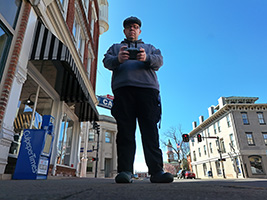Waynesboro Outlet Village
 The Waynesboro Outlet Village opened on Shenandoah Village Drive in 1987 with much fanfare. However, over the course of nearly twenty years, it moved from boom to bust. Boasting nearly full occupancy in its heyday with numerous outlet stores, by 2006, it was down to five stores and a few non-traditional tenants – clearly a “dead mall” by most definitions. Of the five stores remaining, only one, Liz Claiborne, was an outlet store. The complex also had a small identity crisis, as some signage listed it as “Waynesboro Outlet Village”, while other signage listed it as simply “Waynesboro Village”.
The Waynesboro Outlet Village opened on Shenandoah Village Drive in 1987 with much fanfare. However, over the course of nearly twenty years, it moved from boom to bust. Boasting nearly full occupancy in its heyday with numerous outlet stores, by 2006, it was down to five stores and a few non-traditional tenants – clearly a “dead mall” by most definitions. Of the five stores remaining, only one, Liz Claiborne, was an outlet store. The complex also had a small identity crisis, as some signage listed it as “Waynesboro Outlet Village”, while other signage listed it as simply “Waynesboro Village”.
2006 also saw the end of the Waynesboro Outlet Village, as it closed for good on May 31. The complex was demolished, and redeveloped into a new modern shopping center called “Waynesboro Town Center”. It was a shame to see the old Outlet Village go, but they say that everything has its season, and for the Outlet Village, it would seem that its season had passed.
Perhaps the most visible aspect of the Outlet Village was the sign. This sign was visible from a great distance on Interstate 64 and US 340.
At the time of my photo set, a “for sale” sign was posted along Shenandoah Village Drive. Before the Outlet Village closed, this sign was replaced with a sign advertising the new Waynesboro Town Center.
This sign greeted visitors entering through the main entrance. After hours, the sign could be changed to read “CLOSED”.
Parking at the Outlet Village was on the outskirts of the property. In order to reach a storefront, customers had to walk from their car in the parking lot across a road encircling the complex, and then past the buildings themselves to the walkway – a rather long walk. With only two exceptions, there were no outward-facing storefronts, and no buildings had outward-facing signage.
At each entrance, visitors were greeted by a sign. The name was written at the top, a map of the complex was located in the middle, and a directory was at the bottom. The state of the directory was indicative of this facility’s status as a “dead mall”. In the Outlet Village’s heyday, this directory was full.
These welcome signs also illustrated the Outlet Village’s identity crisis. Some signage, like the tall sign and some of the welcome signs, used the older “Waynesboro Outlet Village” logo. Others used a newer “Waynesboro Village” logo. The newer name, however, never caught on with the local community.
These signs helped visitors navigate the Outlet Village, by indicating which stores were right around the corner. In the facility’s heyday, all of these signs were six-tiered. Over the years, some signs were shortened. This was also the only place where “labelscar” (markings left over after signs were removed) could be found, indicating former tenants.
The Outlet Village’s most prominent building was Building 1. Building 1 was the only two-story building, and also the only one to have a brick exterior. While one would think that it would have been used to house a department store or similar anchor store, it never did. In earlier years, it housed a small eatery. Later, as stores left and non-traditional organizations began leasing space, this building housed the Artisans Center of Virginia.
The smallest of all the buildings was Building 18, which formerly housed a tourist information center.
Building 3 was one of the more noteworthy buildings in the Outlet Village, due to its barn-like appearance and adjacent silo. This building originally was home to a Gitano outlet, and later was an early home for the Artisans Center of Virginia. At the time of photography, the left side of the building housed offices for One Child At A Time, which provided academic assistance to high-school students.
The silo originally was painted to advertise the Gitano outlet. After the Gitano outlet left, the silo was repainted to say “Waynesboro Village” in a similar style as the old paintwork. While the Artisans Center occupied the building, the red band said “Artisans Center” in white letters. This was painted out when the Artisans Center relocated to another building in the facility.
In this section of the Outlet Village, a gazebo existed, providing seating for patrons.
Building 5 was somewhat unique in its appearance, as it was taller than most of the other buildings, and lacked a cupola. This building once housed a store called “Petal Pushers” in one of its three spaces. At the time of the facility’s closing, Building 5 housed offices.
A look through a window in Building 4 revealed an empty store. It is unknown who once occupied this space.
Building 4 was built in the typical style for the Waynesboro Outlet Village. Most buildings were covered with vinyl siding of varying colors, had dormers, and contained a cupola. Additionally, as you can see, the facility was well maintained right to the end.
Building 7 was blue-gray in appearance, with typical styling. One non-traditional tenant to occupy a space in this building was Borg-Warner Services, which was a staffing firm that provided employees for CFW Information Services, which had its office further down Shenandoah Village Drive.
7F, the former Borg-Warner office, is now empty and devoid of life. The only indication of this space’s use as an office is a small mailbox on the right wall.
Most buildings contained some type of cupola, either with or without a weather vane. Based on appearance, the various cupolas’ functional purpose appears to have been for ventilation.
The Outlet Village contained two sets of public restrooms. One set was adjacent to Building 2, and another was adjacent to Building 9 (shown here). Perhaps in order to simplify maintenance, the restrooms adjacent to Building 9 were closed.
Over the course of the nineteen years that the Outlet Village was in operation, only one major change was made to the footpath through the complex. This involved navigation around Building 10. The original path took shoppers past Building 9. The path was later rerouted around the other side of Building 10, away from Building 9.
Building 9 is an unusual case, because with only two exceptions, the area around the building was barricaded off with a tall wooden fence.
The fence was an obvious addition, and served to separate Building 9, save for a set of restrooms and one store, from the rest of the facility. It is unknown when the fence was constructed, nor why the fence was constructed, but the fence existed since at least 1997.
Building 10, unlike most of the other buildings, was designed to house a single store.
Inside Building 10, one finds a store with wood paneling on the walls, a raised area to the rear, and a green carpet. The name of the former tenant is unknown.
Building 11 showed signs of life, as Tile Visions, owned by local businessman Paul Gayda, was located here.
This sign, advertising leasing opportunities in the Outlet Village, was located in a window in Building 11. I found this sign to be somewhat amusing, considering that the Outlet Village’s fate was nearly sealed at the time this photo set was made.
In another building, various equipment sits in storage. The combination trash can and ashtray units were formerly located outside all along the walkway, and the brown boxes with the green bases are believed to have come from the former Bass Shoes space.
Building 12 was one that I visited many times in my teenage years, as my mother was quite fond of the Bass Shoes outlet once housed within. The Bass Shoes outlet originally contained a direct connection to the adjacent Van Heusen outlet. When the Van Heusen store closed, a wall was constructed to separate the former Van Heusen space from the still operating Bass Shoes.
The interior of the former Bass Shoes outlet, like most of the other abandoned stores, is dark, quiet, and empty.
The center of the Outlet Village was a service area, officially designated as Building 17. Access was restricted to authorized personnel only, which prevented patrons from making a direct crossing from one side of the complex to the other. Thus in order to get from one end to the other, patrons had to take the longer walk all the way around.
The center area had two access points – one between Buildings 11 and 13 (seen at left), and one further around, between Buildings 15 and 16.
Building 12 was perhaps best known in the facility’s early years for a store called “Fannie Farmer”, which served ice cream. It was one of only two places to eat in the complex, with the other being in Building 1.
Building 13 was once, like most of the buildings in the facility’s heyday, fully occupied. By 2006, the occupant list had dwindled down to one.
One store in Building 13 that lasted into the mid-1990s was the Bugle Boy outlet, whose former space is like most of the others – dark and empty.
However, the other end of Building 13 showed some definite signs of life.
The Liz Claiborne outlet was the single remaining outlet store in the facility. Of all the factory outlet stores that once filled the Outlet Village, this was now the last one.
The store was also somewhat busy, as they were having a “Final Sale” to make way for newer inventory. This was not a going-out-of-business sale, as I had expected when seeing “Final Sale” in the windows.
Building 15 housed a local favorite within its walls, as 15A was the home of the Paper Factory, which was a party supplies store operated by Party America.
Across from the Paper Factory, Building 14, like Building 10, was designed to hold a single store. Unlike many of the empty stores, some fixtures still exist in this space from its last use, though the identity of the former occupant is unknown.
Part of Building 16 was most recently the former home of the Augusta County Railroad Museum. This is also believed to be the former location of Toy Liquidators, a toy outlet store which existed during the Outlet Village’s heyday.
Finally, another part of Building 16 housed the Virginia Metalcrafters store. This space was one of only two spaces in the Outlet Village (with the other being Building 1 housing the Artisans Center) to have an outward-facing storefront.
This area was originally designed for buses to load and unload passengers, but with the arrival of Virginia Metalcrafters, the area was divided up for use as parking for Virginia Metalcrafters customers. This made Virginia Metalcrafters the only store where people could park right by the door.








































































